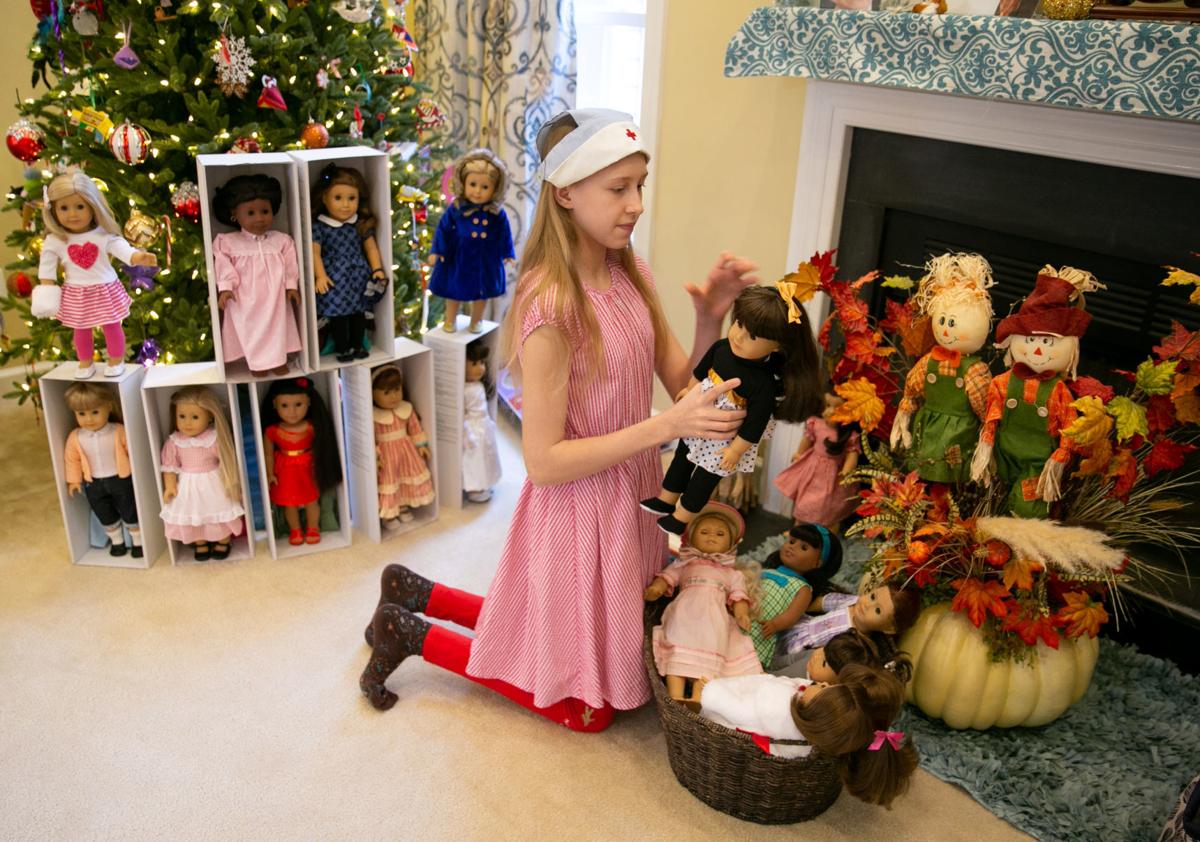STAFFORD GIRL’S PATIENTS WILL GO TO ORPHANS
By CATHY DYSON THE FREE LANCE–STAR Dec 4, 2019
Photos by MIKE MORONES THE FREE LANCE-STAR
Borrowed with permission from: Fredericksburg.com
Leah Barcus rubbed her hand over the doll’s mangled fingers, then seemed to look beyond the damage.
The 12-year-old is restoring 25 American Girl dolls that have been used or abused so she can give them as Christmas presents to orphans. As the Stafford County girl held the tiny plastic hand, she wondered about those who would later do the same and if they, too, had been scarred by life.
“These girls may not like the new dolls in the store,” Leah said. “They’re just too perfect. They’re not like real people.”
And just as human patients sometimes need help from doctors, dolls require the same attention, and Leah is learning all she can to provide it.
Leah didn’t grow up with American Girl dolls, collectibles that have been around since 1986 and feature more than just a pretty face. All have backstories, ranging from a Jewish doll named Rebecca who immigrated from Russia to America in 1914, to Addy, who was born into slavery in 1864 and found her freedom in the North.
Leah got her first doll a year ago because her best friend had one. That led to a research paper on the history of American Girl dolls for one of the seventh-grader’s home-school lessons.
Then, when she got another doll whose arm didn’t fit snugly in its socket, Leah wondered how American Girl dolls get the TLC they occasionally need.
Leah balked at the idea of mailing her doll back to the manufacturer and the high cost of repairs. So, the next thing her parents, Allison and Terry Barcus, knew, Leah was watching videos on doll repairs and setting up the “Joy Doll Hospital” throughout their home.
In the kitchen, the “doll doctor” learned how to dunk doll hair in boiling water for just the right amount of time, then rinse it in cold water, to remove accumulated gunk. She had to be careful not to get water in their eyes, lest the dolls develop rust and a condition called “silver eye.”
Leah arranged a table in the living room where she used modified wire-cutters and needle-nose pliers from her grandpa’s toolbox, or even hair pins, to undo strings that held the heads, bodies and limbs in place. She restrung them and added new crimps and tighter knots to get rid of looseness in the limbs.
Leah definitely knows how to get the American Girls all dolled up, said Susan Mathias, vice president of the international Doll Doctor’s Association. The group has about 150 members worldwide and maybe two—one in Texas and another in Pennsylvania—who work on American Girl dolls.
“We have never, ever had a 12-year-old young lady interested in being a doll doctor,” Mathias said. “For her, at 12, to be able to do these things, do them in a timely fashion and do a good job is amazing.”
‘ABSOLUTELY FANTASTIC’
Leah met Mathias in mid-October at a Doll Doctor’s Association show in Spotsylvania County. As Leah approached the doctor’s table, two women presented American Girl dolls that needed repairs. Leah took them home, cleaned them up and brought them back to the doll show the same day.
“It was absolutely fantastic,” Mathias said.
Leah is also interested in drama and theater, and as she traveled to Greensville, S.C., to be part of family-friendly productions at The Logos Theatre, she kept seeing signs for a children’s home.
“What is that?” Leah wondered. “I didn’t know [orphanages] still existed.”
She and her mother researched online and found there were, indeed, several homes for boys and girls awaiting adoption. Leah decided to collect dolls in need of a second chance and restore them to good, playable condition.
What better Christmas project than to give them to “a girl that would probably never have a doll, much less an expensive, popular, quality doll?” Leah asked.
Brand new, an American Girl doll costs about $115 and includes a book about her life story. Some of the older models of dolls, such as Felicity—who lived through the American Revolution—or Josefina the Mexican girl, are worth more than three times that much.
MORE THAN A MAKEOVER
With money fronted by her parents, Leah started searching online sites and buying batches of dolls. When she’s told the sellers about her project—which has grown to include three children’s homes—they sometimes toss in additional clothes.
Fellow members at Summit Presbyterian Church also have sewn doll dresses—in the correct period clothing, of course—and helped Leah with the cost.
She’s spending an estimated $60 per doll for replacement parts, clothes, accessories and the official American Girl box in which the dolls will be packaged. Leah has set up booths at church and local events to help find sponsors. She also uses any money earned by her doll doctoring to cover expenses.
Anyone interested in helping with her project—or whose American Doll is in need of a makeover—can visit www.joydollhospital.org.
‘THEY CAN BE YOUR SISTER’
Before Leah was interviewed, she purposely turned around the doll heads she had removed for cleaning so girls wouldn’t see their faces and be frightened. She didn’t want to divulge too many details about repairs for the same reason.
While she’s gleaned a lot from fellow doll doctors and videos, she’s also learned by doing. She’s cleaned dolls sticky with syrup or those whose perfectly round cheeks were stained by black spots or orange markers.
Sometimes, a makeup sponge and “Magic Eraser” product do the trick; other times, she’s scrubbed with anti-bacterial wipes or applied acne medicine.
When she gives demonstrations or mans a booth asking for sponsors, Leah dons a pale blue jumper and nurse’s cap that her grandmother wore when she was a Red Cross nurse in the 1950s.
The American Girl venture has taught her a lot about various periods of history. She’s learned the medical needs of stuffed playthings as well as how to interact with sellers and sponsors. And she’s gotten really good at doing hair—even complex styles like the two looped braids worn by Kirsten, the Swedish girl.
Leah’s “hospital” is the first thing she runs to each morning, said her mother, who brings her back to the reality of home-school work.
“I love playing with my dolls. I think that having a doll makes your imagination come to life, especially if you don’t have a family,” said Leah, who has a younger brother, Troy. “They can be your sister. That’s what they are to me.”

